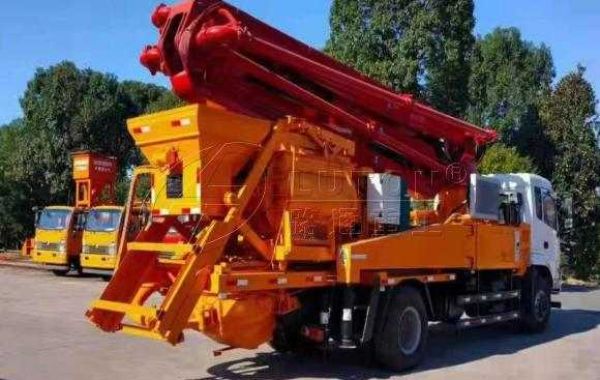The working principle of a concrete pump truck is mainly based on the collaborative operation of its pumping system and material distribution system. Here is a detailed explanation.
Working Principle of Pumping System
The pumping system of a concrete pump truck is its core component, mainly responsible for pressurizing concrete from the hopper into the pipeline, and then transporting it to the pouring point through the pipeline. According to the different types of pumping mechanisms, concrete pump trucks are mainly divided into two categories: extrusion type and piston type.
Squeezing Concrete Pump Truck
- Working Principle
By using the roller to squeeze the rubber tube during rolling, the rubber tube has the ability to suck in and output concrete. The drive shaft drives the roller frame and rollers to rotate, constantly squeezing the rubber hose. At the same time, the vacuum pump continuously extracts air, creating negative pressure inside the pump body to help suck in concrete. The supporting roller supports the compressed hose to quickly recover, improving the suction performance of concrete.
- Characteristics
The pressure and displacement are relatively small, suitable for situations where pumping capacity is not required.
Piston Type Concrete Pump Truck
- Work Principle
The piston of the concrete conveying cylinder is driven by an oil cylinder to reciprocate and such or press concrete. The reciprocating motion of the piston is driven by a hydraulic pump, and the piston is reversed through a directional valve. When the piston moves forward, it sucks in concrete; When moving backwards, press the concrete.
- Features
High pressure and displacement, high pumping efficiency, widely used in various large-scale construction projects.
The Working Principle Of The Boom System
The boom system mainly consists of multiple arm frames, connecting roads, oil cylinders, and other components, responsible for directly delivering the concrete pumped out by the pumping system to the pouring point.
- Arm deployment and retraction
The deployment and retraction of each arm section are completed by each arm cylinder. The operator controls the extension and retraction of the oil cylinder to expand or retract the boom according to the predetermined trajectory.
- Arm Frame Rotation
The arm frame can be driven by a rotary motor and reducer to rotate the large bearing around the fixed turret for 365°. In this way, operators can flexibly adjust the orientation of the boom to ensure accurate delivery of concrete to the pouring point.
- Terminal Hose Operation
The end of the boom is usually equipped with a hose, which is used to transport concrete to the specific pouring site. The operator can adjust the pouring position and range of concrete by controlling the swing and expansion of the hose.
Working Principle Of Power Transmission System
The power transmission system of a concrete pump truck mainly consists of components such as the engine, power transfer case, and transmission shaft, which are responsible for transmitting the power of the engine to the hydraulic pump group or rear axle.
- Engine
Provides the power source for the operation of the pump truck.
- Power Transfer Case
By using a pneumatic device to push the fork in the transfer case, the fork drives the clutch sleeve to switch the engine’s power to the hydraulic pump group or rear axle. When switching to the hydraulic pump group, drive the pumping system and fabric system to work; When switching to the rear axle, drive the pump truck to travel.
- Drive shaft
Transmits power from the engine to the hydraulic pump assembly or rear axle.
For more details on concrete pump truck, please land on the website ltconcretepump.com.
In summary, the concrete pump truck pressurizes the concrete through the pumping system and sends it into the pipeline, and then transports it to the pouring point through the arm and hose of the fabric system. The power transmission system is responsible for transmitting the engine’s power to the hydraulic pump group or rear axle to drive the pumping system and fabric system.








